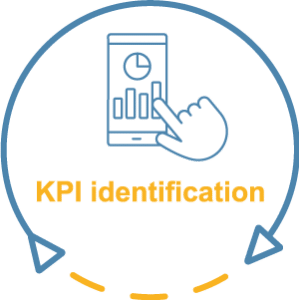Tracking the Success of Your Practice’s PPC Campaign
So, you’ve finally decided to start a paid advertising campaign. Congrats! Just like with any of your marketing efforts, you want to be able to gauge how well it may or may not be performing, especially because you are paying for the ads.
You want to be able to track the performance and effectiveness of your campaign to make sure you’re maximizing your return on investment.
As a small business, it can seem difficult to determine whether or not the money you’re spending is actually helping to draw in more clients for you. But we’re here to make the process of tracking and analyzing your PPC easier.
 Compare Your Results to Your Goals
Compare Your Results to Your Goals
Before even beginning your campaign, we hope you set specific goals for you and your team. Tailor your objectives to your practice. Remember not to compare the goals you have set for your practice to that of others because everyone has different needs.
As you are deciding on what goals you want to meet, it’s important to consider things like:
- Creating brand and product awareness
- Boosting traffic to your website
- Converting leads into actual sales
- Increasing your email list
When you set certain goals for yourself, it makes it easier to hone in on what metrics you should really be focused on.
4 Key Elements to Evaluating KPIs
After you’ve allowed your campaign to run for some time, you need to review your key performance indicators (KPIs). Your KPIs are the main metrics that you should pay attention to when running your campaign.
Here are 4 key elements to look at when measuring how well your PPC strategy is doing:
1. Conversion Rate
First off, what exactly is a conversion rate? Well, it refers to the percentage of people who visited your site and have completed a call to action on a webpage or were converted into customers.

This metric allows you to see if your paid ads are actually turning onlookers into patients or clients and at what rate. You can do conversion tracking for any and all ads that you pay for.
In order to know how well your campaign is doing, you have to know what qualifies as a high conversion rate. Ideally, a good conversion rate should be based on what percentage you’re at currently and what percentage you want to achieve.
According to Wordstream, the average conversion rate among businesses was 2.35% but the top 25% were reaching a rate of 5.31% or higher. Then, of course, there are those businesses with extraordinary percentages of 10% or more. But, that varies based on what industry you are in and what type of business you own.
Conversion rate is one of the most important metrics to gauge how successful your campaign is. This is because the percentage is what digital marketers are looking at to know whether or not the ads, and the landing pages that the ads lead to, are strong enough to convert a visitor into a patient or client.
If you are hitting your desired percentage, that’s great! If you’re not quite there yet, think about what can you do to change things up. Some examples of how you can increase your conversion are:
-
- Clearly state how beneficial your products and services are to prospects
- Include a call to action on web pages throughout your website
- Show customer reviews
- Use A/B split testing for your landing pages
- Offer discounts
These are just a few helpful ways to get you started on how to encourage visitors to become actual customers.
 2. Click-Through Rate
2. Click-Through Rate
Click-through rate, or CTR, is the number of individuals who viewed your ad, email or web page versus those who actually clicked on it.
The number of times that your advertisement was shown is called impressions. To calculate your CTR, you have to divide the number of clicks your ad received by its impressions.
For example, if your ad gets 5,000 impressions and 200 people who clicked on it, you get 0.04. You then multiply that by 100 to get your percentage. Continuing with this example, you would get the number 4. This indicates that 4% of prospects who saw your ad clicked on it and were directed to your website.
When looking at this metric, be mindful that this percentage of prospects who clicked through to your site and not those who decided to purchase a product or service.
CTR is one of the key metrics for analyzing the success of your PPC campaign and overall performance.

3. Cost Per Click
When you hear the term cost per click, or CPC, it means exactly what it says. How much will your business have to spend in order to attract new clients?
Most businesses typically have a predetermined budget and that indicates exactly how much of your revenue you are able to use for paid ads.
If the entirety of your PPC campaign is more expensive than how much you earn on a new sale, you might want to revisit your budget and make the necessary adjustments that will help your business earn more in sales than what you spend on ads.
4. Quality Score
For the final, and what some call the most important KPI, we have quality score. Your quality score measures how relevant your landing pages, content keywords, and ads are to viewers. Every keyword in your campaign is given a score and that is calculated whenever one of your keywords is brought up by what a potential customer searched for.
A high quality score indicates how useful Google thinks ads are to users. If the keywords used in your campaign are relevant to what users are searching for, the higher your quality score will be.
Overall Performance
It’s imperative that you analyze all the details of your campaign and how well it’s doing in order to know if you’re spending your money on ads wisely. Based on what industry you’re in, you have to decide what techniques work best for you and which ones should be reconfigured so that you rank against your competition.
If your campaign has not gone as you planned so far, don’t worry. There is always room for growth and more opportunities to attract new customers.
Have more questions about launching a successful PPC campaign?
Check out these other resources:
Creating PPC Ads to Attract Your Ideal Patients
Creating an Effective PPC Landing Page
How to Target Your Ideal Clients with Local Marketing



